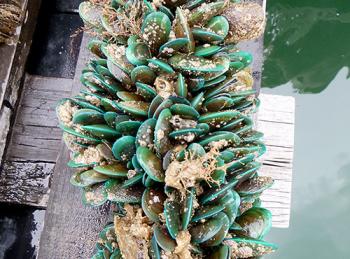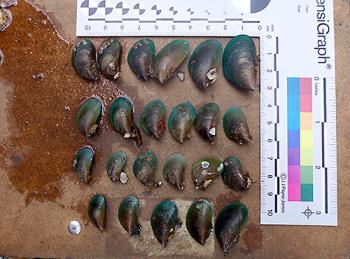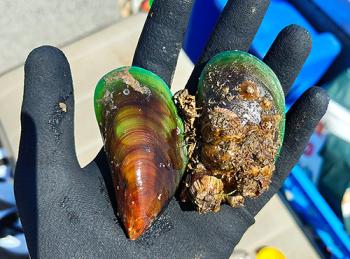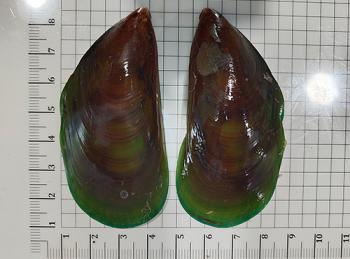Asian green mussel (Perna viridis) is an invasive marine pest that may out-compete native species and impact aquaculture and other marine based industries in Australia.
Detection in Australia
Since September 2024, Asian green mussels have been detected on vessel hulls and marine infrastructure in waters near Weipa in far north Queensland.
Biosecurity Queensland is conducting surveillance activities to determine the extent of the outbreak, including settlement plate inspections, eDNA surveillance, and underwater inspections of wharves, pylons and moorings.
It is unknown how the mussels originally arrived in Australia, but Asian green mussels are known to attach themselves to vessels as biofouling or can possibly be transported in vessel’s ballast water.
Response program
The lead agency for this response is Biosecurity Queensland. Based on the detections of Asian green mussel, it’s important to determine if there are more present and their extent in the Weipa region.
Early detection will increase the potential for eradication if numbers are small and limited to a small area. The Consultative Committee on Introduced Marine Pest Emergencies (CCIMPE) has met to decide on next steps to manage the response to these detections. A response plan is currently being developed to guide response activities.
Your obligations
Asian green mussel is a prohibited marine animal under Queensland’s Biosecurity Act 2014. Everyone has a biosecurity obligation to take all reasonable and practical steps to minimise the risk of Asian green mussel spreading.
Vessel owners should maintain their boat’s cleanliness and manage biofouling. Biofouling is any marine growth, such as algae or mussels, that attach to the underside of a vessel or on propellors and rudders. For additional information on cleaning of recreational vessels please visit the marine pest website.
Where possible, vessels should be removed from the water before any biofouling is removed. This will help prevent the spread of any potential marine pests.
Yachts and other vessels entering Australian waters from overseas must comply with biosecurity conditions set by the Australian Government Department of Agriculture, Fisheries and Forestry (DAFF).
It is important that people who work in or use our marine environment for commercial or recreational activities are aware of the potential for transfer of marine pests.
Biosecurity Queensland is encouraging water users in the Weipa region to remain vigilant for Asian green mussel. If you spot something unusual in Queensland waters or on marine vessels and infrastructure, contact Biosecurity Queensland on 13 25 23 or complete the online reporting form.
In other jurisdictions, you should report anything unusual or suspected marine pests to your local department of primary industries or fisheries.
About the pest
Asian green mussel is highly variable in colour when young, ranging from brown, sometimes with stripes, to the more typical green. At maturity it is more of a dark green-to-blue, green-to-brown with a green margin.
The shell’s exterior is smooth with concentric growth rings. The interior of the shell is smooth, iridescent pale blue to green, with a finely pitted ridge for ligament attachment.
The mussel generally grows to between 80 mm and 100 mm in shell length. At a maximum they can grow up to 160 mm.
Asian green mussel is a nationally significant marine pest and listed on the Australian Priority Marine Pest List (APMPL) and the National Priority List of Exotic Environmental Pests, Weeds and Diseases (EEPL).
It is native to the northern Indo-Pacific, occurring along the Indian and South-East Asian coasts including Malaysia, Indonesia and Singapore.
The mussel can be transported in ship ballast water, on vessel hulls, in internal seawater systems and on items such as aquaculture equipment. It can have economic impacts as it fouls vessel hulls, seawater systems, industrial intake pipes, wharves and buoys and shellfish aquaculture stock and equipment.

Photo courtesy: Justin McDonald

Photo courtesy: Justin McDonald

Photo courtesy: Biosecurity Queensland Resources

Photo courtesy: Biosecurity Queensland Resources
Resources
More information on identifying Asian green mussel is available at: